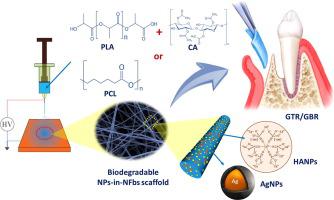Journal of Advanced Research ( IF 11.4 ) Pub Date : 2020-06-20 , DOI: 10.1016/j.jare.2020.06.014 Dina Abdelaziz 1, 2 , Amr Hefnawy 1 , Essam Al-Wakeel 2 , Abeer El-Fallal 2, 3 , Ibrahim M El-Sherbiny 1

|
Introduction
Guided tissue regeneration (GTR) and guided bone regeneration (GBR) are commonly used surgical procedures for the repair of damaged periodontal tissues. These procedures include the use of a membrane as barrier to prevent soft tissue ingrowth and to create space for slowly regenerating periodontium and bone. Recent approaches involve the use of membranes/scaffolds based on resorbable materials. These materials provide the advantage of dissolving by time without the need of surgical intervention to remove the scaffolds.
Objectives
This study aimed at preparing a new series of nanofibrous scaffolds for GTR/GBR applications with enhanced mechanical properties, cell adhesion, biocompatibility and antibacterial properties.
Methods
Electrospun nanofibrous scaffolds based on polylactic acid/cellulose acetate (PLA/CA) or poly(caprolactone) (PCL) polymers were prepared and characterized. Different concentrations of green-synthesized silver nanoparticles, AgNPs (1-2% w/v) and hydroxyapatite nanoparticles, HANPs (10-20% w/v) were incorporated into the scaffolds to enhance the antibacterial and bone regeneration activity.
Results
In-vitro studies showed that addition of HANPs improved the cell viability by around 50% for both types of nanofibrous scaffolds. The tensile properties were also improved through addition of 10% HANPs but deteriorated upon increasing the concentration to 20%. AgNPs significantly improved the antibacterial activity with 40 mm inhibition zone after 32 days. Additionally, the nanofibrous scaffolds showed a desirable degradation profile with losing around 40-70% of its mass in 8 weeks.
Conclusions
The obtained results show that the developed nanofibrous membranes are promising scaffolds for both GTR and GBR applications.
中文翻译:

新型可生物降解纳米纤维纳米纤维膜用于引导牙周组织和骨再生,具有增强的抗菌活性
介绍
引导组织再生(GTR)和引导骨再生(GBR)是修复受损牙周组织的常用外科手术。这些程序包括使用膜作为屏障,以防止软组织向内生长,并为牙周组织和骨骼的缓慢再生创造空间。最近的方法涉及使用基于可吸收材料的膜/支架。这些材料具有随时间溶解而无需手术干预来移除支架的优点。
目标
本研究旨在制备一系列用于 GTR/GBR 应用的新型纳米纤维支架,这些支架具有增强的机械性能、细胞粘附性、生物相容性和抗菌性能。
方法
制备并表征了基于聚乳酸/醋酸纤维素 (PLA/CA) 或聚 (己内酯) (PCL) 聚合物的电纺纳米纤维支架。将不同浓度的绿色合成银纳米粒子AgNPs (1-2% w/v) 和羟基磷灰石纳米粒子HANPs (10-20% w/v) 掺入支架中以增强抗菌和骨再生活性。
结果
体外研究表明,添加 HANPs 可将两种类型的纳米纤维支架的细胞活力提高约 50%。拉伸性能也通过添加 10% 的 HANPs 得到改善,但在浓度增加到 20% 时会恶化。32 天后,AgNPs 显着提高了 40 mm 抑菌圈的抗菌活性。此外,纳米纤维支架显示出理想的降解特性,在 8 周内损失了约 40-70% 的质量。
结论
获得的结果表明,开发的纳米纤维膜是用于 GTR 和 GBR 应用的有前途的支架。









































 京公网安备 11010802027423号
京公网安备 11010802027423号